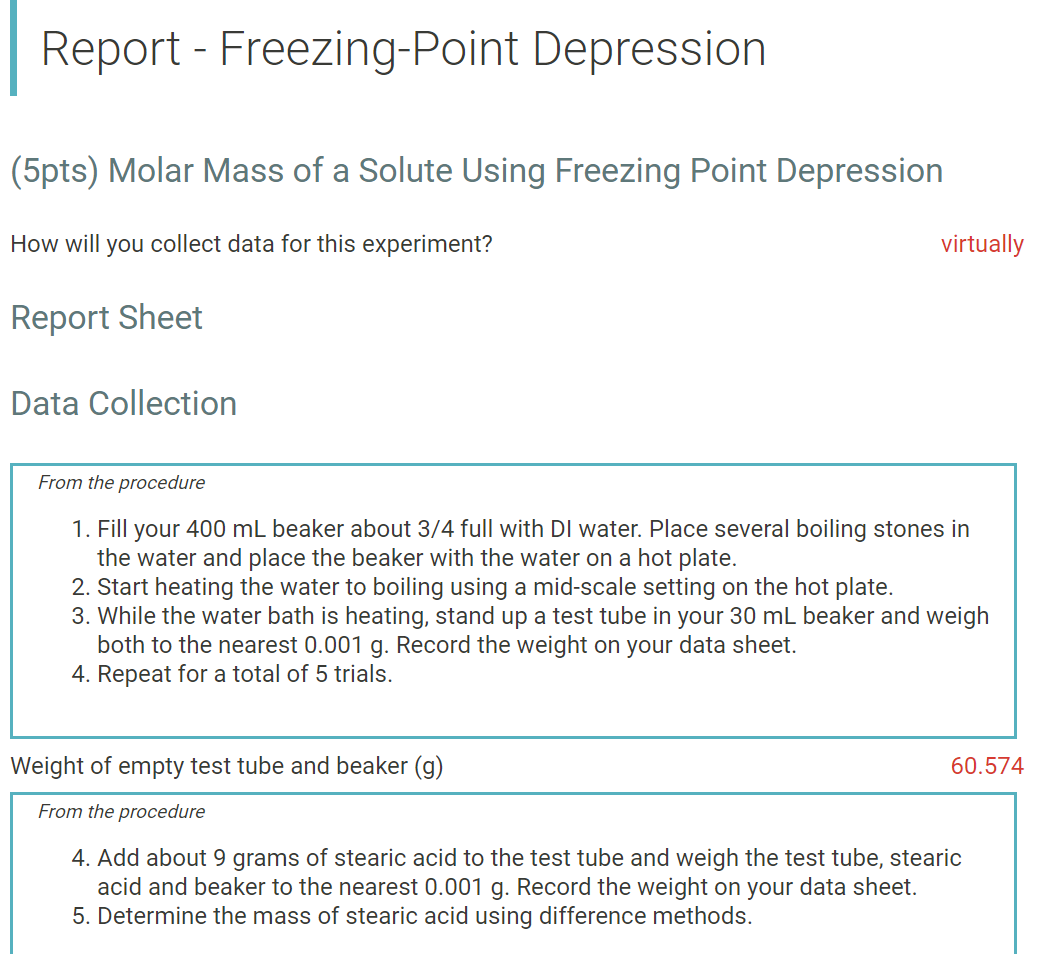
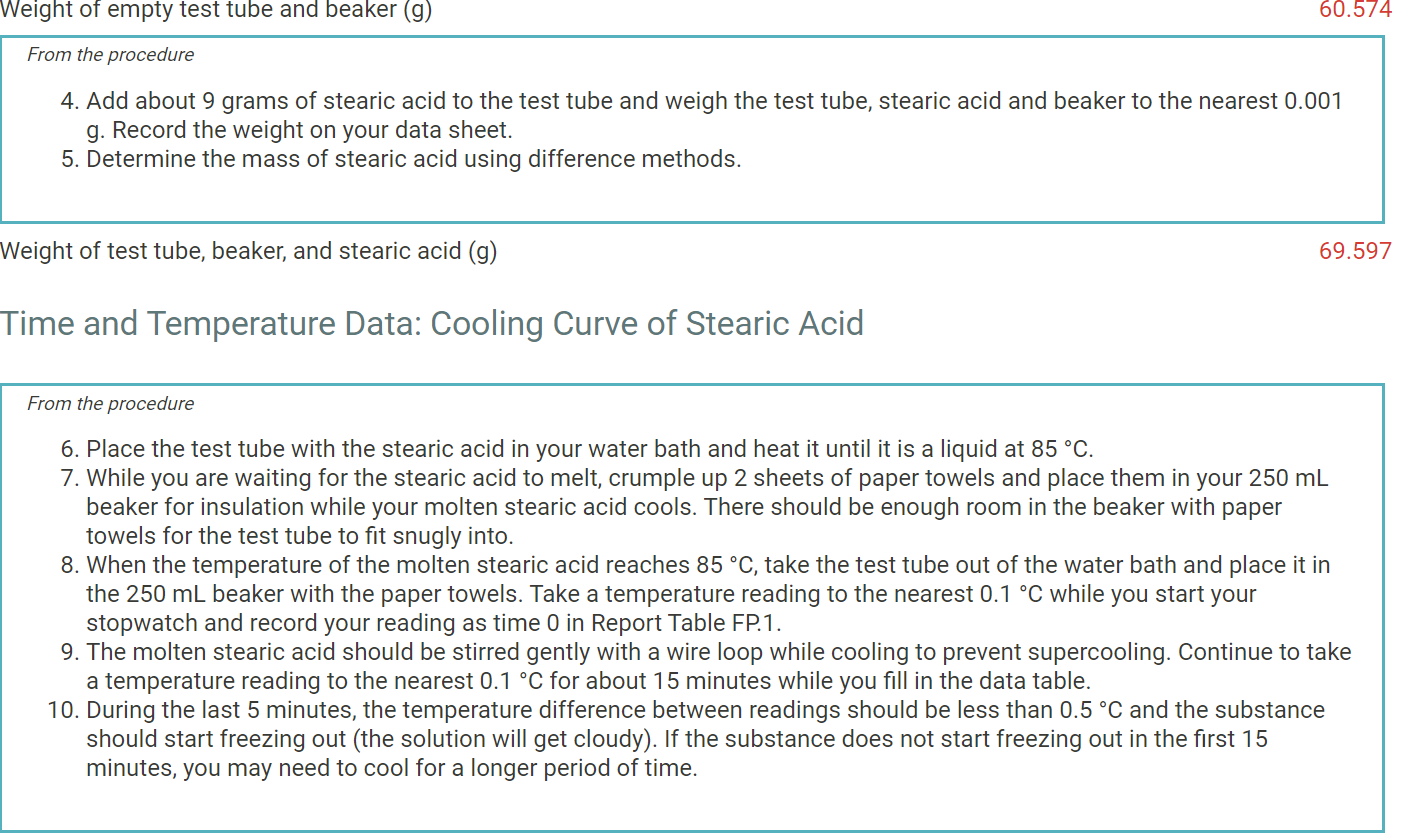
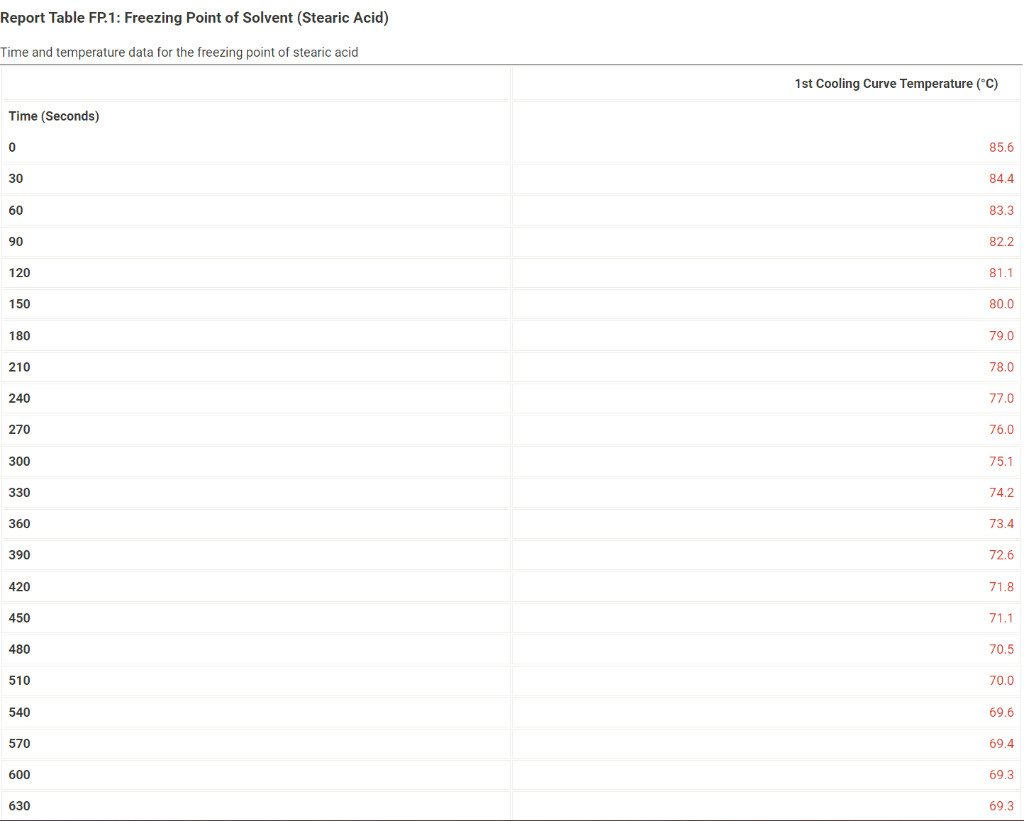
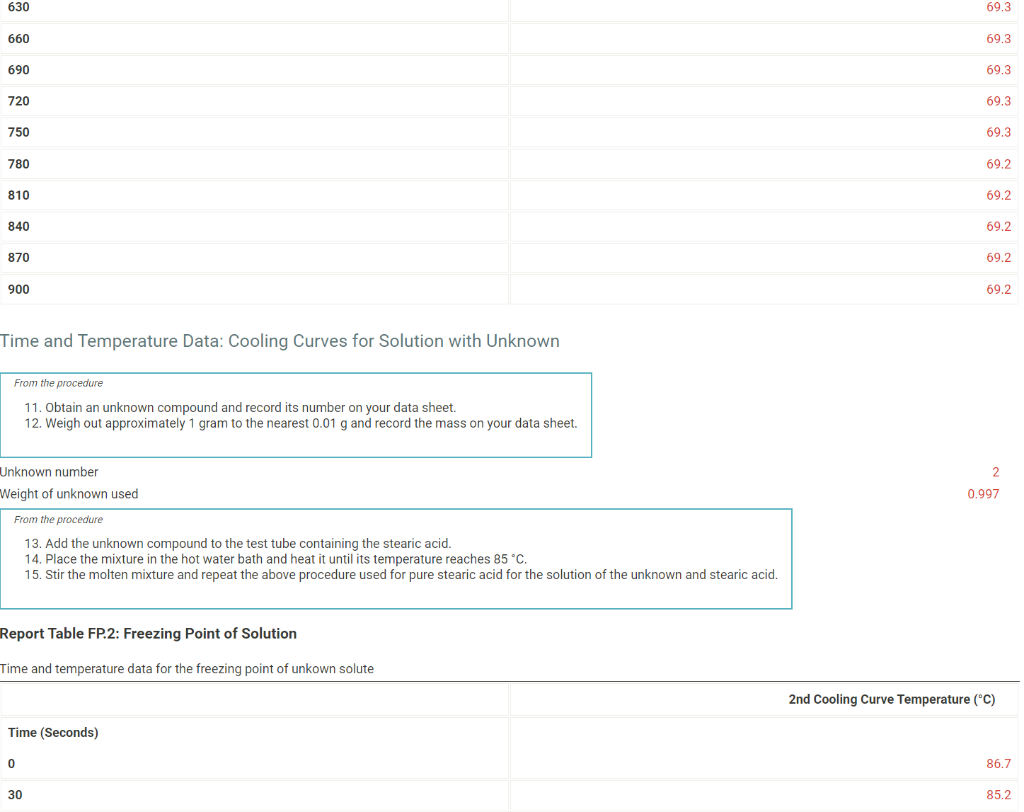

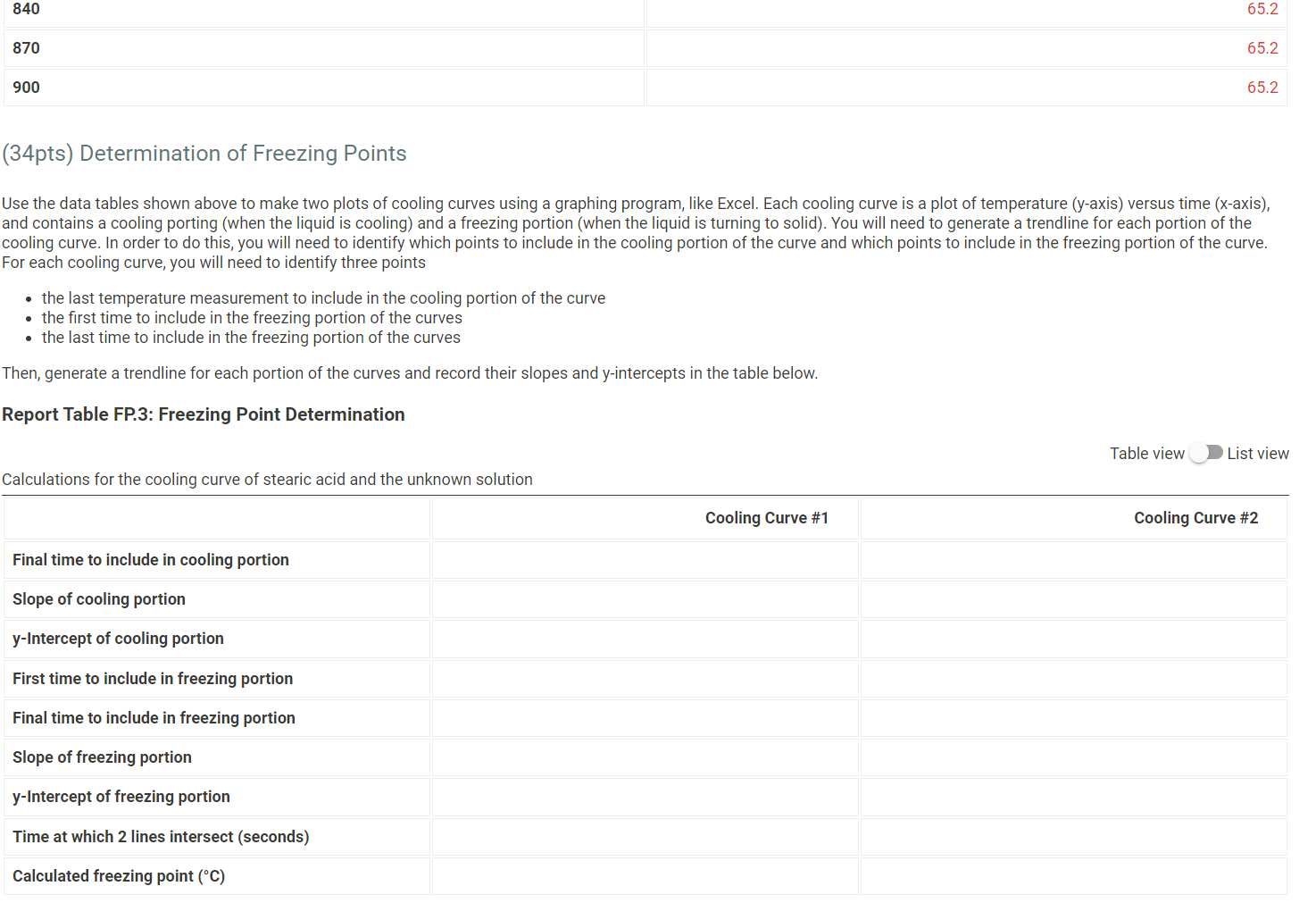
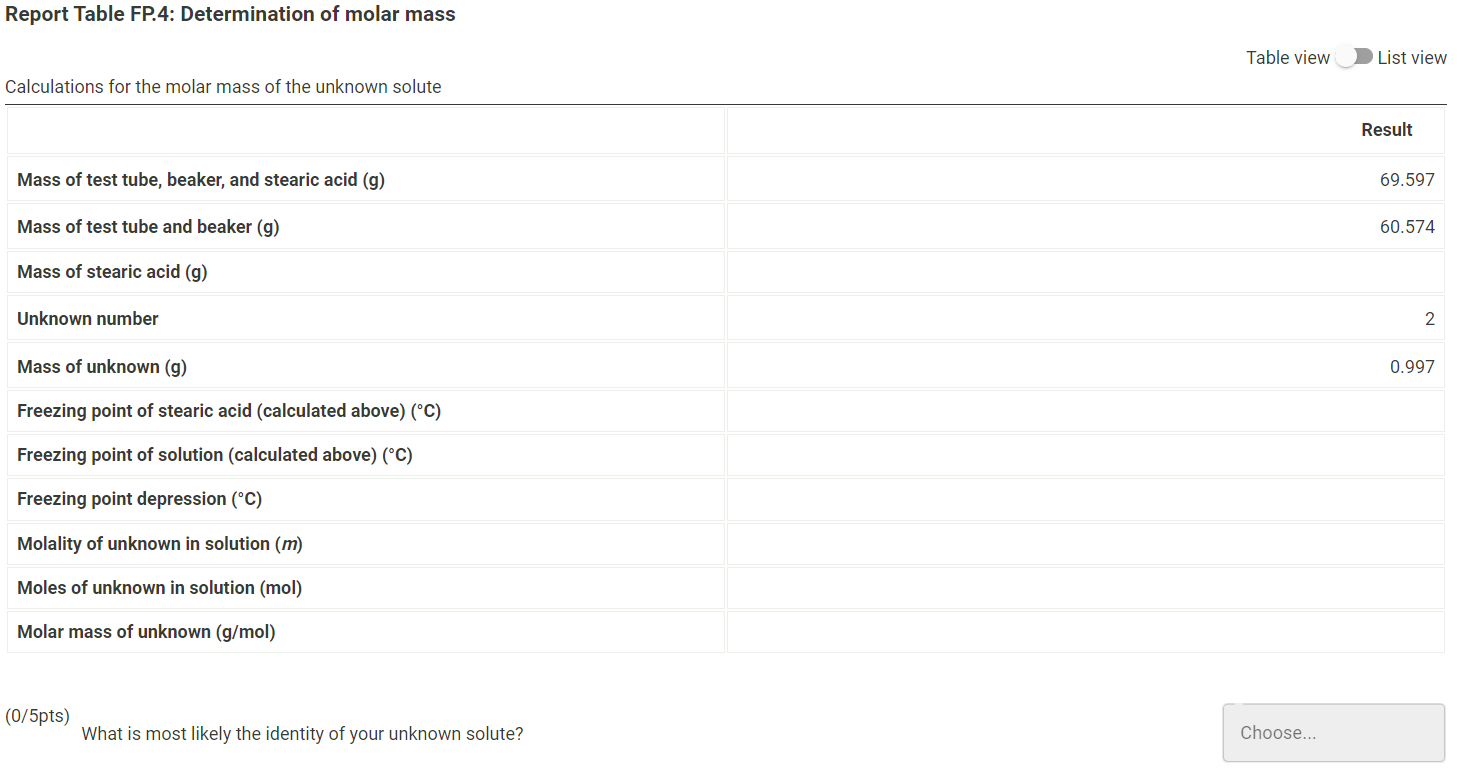
Report - Freezing-Point Depression (5pts) Molar Mass of a Solute Using Freezing Point Depression How will you collect data for this experiment? virtually Report Sheet Data Collection From the procedure 1. Fill your 400 ml beaker about 3/4 full with Dl water. Place several boiling stones in the water and place the beaker with the water on a hot plate. 2. Start heating the water to boiling using a mid-scale setting on the hot plate. 3. While the water bath is heating, stand up a test tube in your 30 ml beaker and weigh both to the nearest 0.001 g. Record the weight on your data sheet. 4. Repeat for a total of 5 trials. Weight of empty test tube and beaker (g) 60.574 From the procedure 4. Add about 9 grams of stearic acid to the test tube and weigh the test tube, stearic acid and beaker to the nearest 0.001 g. Record the weight on your data sheet. 5. Determine the mass of stearic acid using difference methods. Weight of empty test tube and beaker (g) 60.574 From the procedure 4. Add about 9 grams of stearic acid to the test tube and weigh the test tube, stearic acid and beaker to the nearest 0.001 g. Record the weight on your data sheet. 5. Determine the mass of stearic acid using difference methods. Weight of test tube, beaker, and stearic acid (g) 69.597 Time and Temperature Data: Cooling Curve of Stearic Acid From the procedure 6. Place the test tube with the stearic acid in your water bath and heat it until it is a liquid at 85 C. 7. While you are waiting for the stearic acid to melt, crumple up 2 sheets of paper towels and place them in your 250 ml beaker for insulation while your molten stearic acid cools. There should be enough room in the beaker with paper towels for the test tube to fit snugly into. 8. When the temperature of the molten stearic acid reaches 85 C, take the test tube out of the water bath and place it in the 250 ml beaker with the paper towels. Take a temperature reading to the nearest 0.1 C while you start your stopwatch and record your reading as time 0 in Report Table FP.1. 9. The molten stearic acid should be stirred gently with a wire loop while cooling to prevent supercooling. Continue to take a temperature reading to the nearest 0.1 C for about 15 minutes while you fill in the data table. 10. During the last 5 minutes, the temperature difference between readings should be less than 0.5 C and the substance should start freezing out (the solution will get cloudy). If the substance does not start freezing out in the first 15 minutes, you may need to cool for a longer period of time. Report Table FP.1: Freezing Point of Solvent (Stearic Acid) Time and temperature data for the freezing point of stearic acid 1st Cooling Curve Temperature (C) Time (Seconds) 0 85.6 30 84.4 60 83.3 90 82.2 120 81.1 150 80.0 180 79.0 210 78.0 240 77.0 270 76.0 300 75.1 330 74.2 360 73.4 390 72.6 420 71.8 450 71.1 480 70.5 510 70.0 540 69.6 570 69.4 600 69.3 630 69.3 630 69.3 660 69.3 690 69.3 720 69.3 750 69.3 780 69.2 810 69.2 840 69.2 870 69.2 900 69.2 Time and Temperature Data: Cooling Curves for Solution with Unknown From the procedure 11. Obtain an unknown compound and record its number on your data sheet. 12. Weigh out approximately 1 gram to the nearest 0.01 g and record the mass on your data sheet. Unknown number Weight of unknown used 2 0.997 From the procedure 13. Add the unknown compound to the test tube containing the stearic acid. 14. Place the mixture in the hot water bath and heat it until its temperature reaches 85 C. 15. Stir the molten mixture and repeat the above procedure used for pure stearic acid for the solution of the unknown and stearic acid. Report Table FP.2: Freezing Point of Solution Time and temperature data for the freezing point of unkown solute 2nd Cooling Curve Temperature (C) Time (Seconds) 0 86.7 30 85.2 60 83.7 90 82.2 120 80.8 150 79.4 180 78.0 210 76.7 240 75.4 270 74.2 300 72.9 330 71.8 360 70.7 390 69.6 420 68.6 450 67.7 480 66.9 510 66.2 540 65.7 570 65.5 600 65.4 630 65.4 660 65.3 690 65.3 720 65.3 750 65.3 780 65.2 810 65.2 840 65.2 870 65.2 900 65.2 (34pts) Determination of Freezing Points Use the data tables shown above to make two plots of cooling curves using a graphing program, like Excel. Each cooling curve is a plot of temperature (y-axis) versus time (x-axis), and contains a cooling porting (when the liquid is cooling) and a freezing portion (when the liquid is turning to solid). You will need to generate a trendline for each portion of the cooling curve. In order to do this, you will need to identify which points to include in the cooling portion of the curve and which points to include in the freezing portion of the curve. For each cooling curve, you will need to identify three points the last temperature measurement to include in the cooling portion of the curve the first time to include in the freezing portion of the curves the last time to include in the freezing portion of the curves Then, generate a trendline for each portion of the curves and record their slopes and y-intercepts in the table below. Report Table FP.3: Freezing Point Determination Table view List view Calculations for the cooling curve of stearic acid and the unknown solution Cooling Curve #1 Cooling Curve #2 Final time to include in cooling portion Slope of cooling portion y-Intercept of cooling portion First time to include in freezing portion Final time to include in freezing portion Slope of freezing portion y-Intercept of freezing portion Time at which 2 lines intersect (seconds) Calculated freezing point (C) Report Table FP.4: Determination of molar mass Table view List view Calculations for the molar mass of the unknown solute Result Mass of test tube, beaker, and stearic acid (g) 69.597 Mass of test tube and beaker (9) 60.574 Mass of stearic acid (9) Unknown number 2 Mass of unknown (9) 0.997 Freezing point of stearic acid (calculated above) (C) Freezing point of solution (calculated above) (C) Freezing point depression (C) Molality of unknown in solution (m) Moles of unknown in solution (mol) Molar mass of unknown (g/mol) (0/5pts) What is most likely the identity of your unknown solute? Choose













